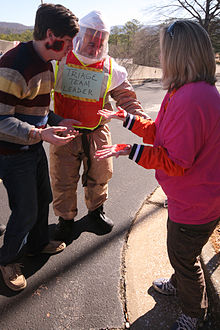
Back Hromadné neštěstí Czech Massenanfall von Verletzten German אירוע רב-נפגעים HE Wypadek masowy Polish 大量傷患事件 Chinese
The examples and perspective in this article may not represent a worldwide view of the subject. (January 2020) |

A mass casualty incident (often shortened to MCI) describes an incident in which emergency medical services resources, such as personnel and equipment, are overwhelmed by the number and severity of casualties.[1] For example, an incident where a two-person crew is responding to a motor vehicle collision with three severely injured people could be considered a mass casualty incident. The general public more commonly recognizes events such as building collapses, train and bus collisions, plane crashes, earthquakes and other large-scale emergencies as mass casualty incidents. Events such as the Oklahoma City bombing in 1995, the September 11 attacks in 2001, and the Boston Marathon bombing in 2013 are well-publicized examples of mass casualty incidents. The most common types of MCIs are generally caused by terrorism, mass-transportation accidents, fires or natural disasters. A multiple casualty incident is one in which there are multiple casualties. The key difference from a mass casualty incident is that in a multiple casualty incident the resources available are sufficient to manage the needs of the victims. The issue of resource availability is therefore critical to the understanding of these concepts. One crosses over from a multiple to a mass casualty incident when resources are exceeded and the systems are overwhelmed.
- ^ Mistovich, Joseph J.; Karren, Keith J.; Hafen, Brent (2013). Prehospital Emergency Care. Prentice Hall. ISBN 978-0133369137.
© MMXXIII Rich X Search. We shall prevail. All rights reserved. Rich X Search